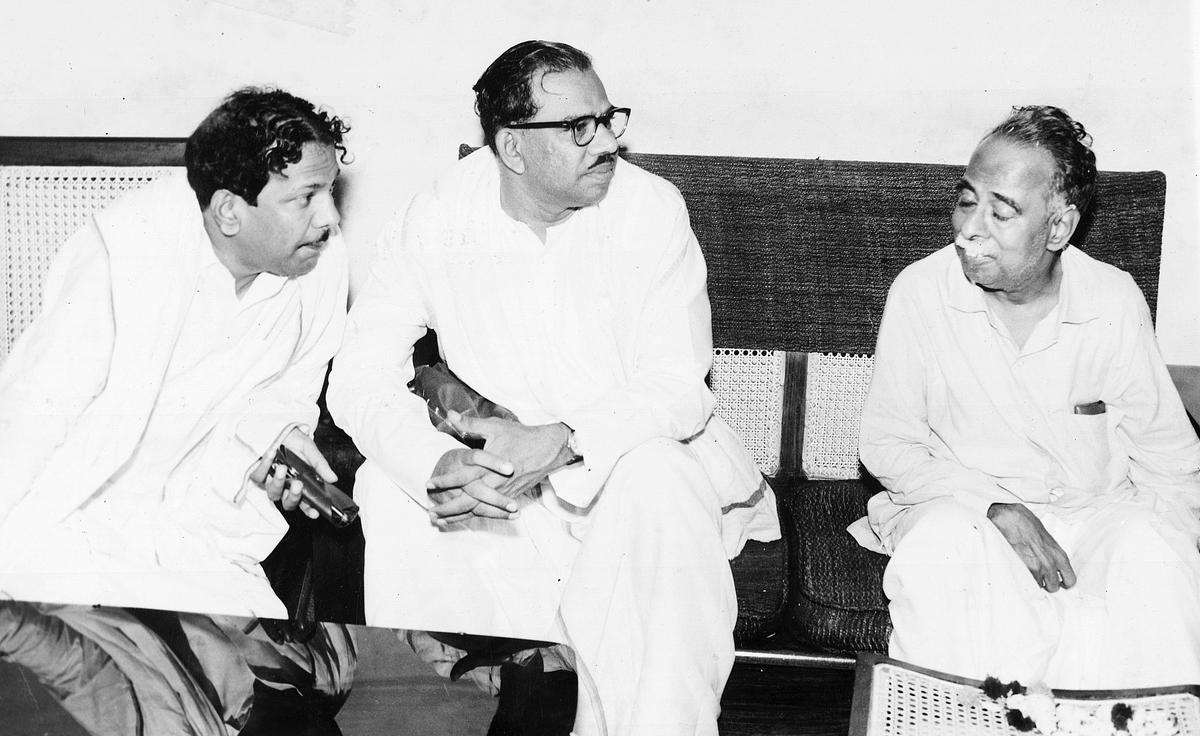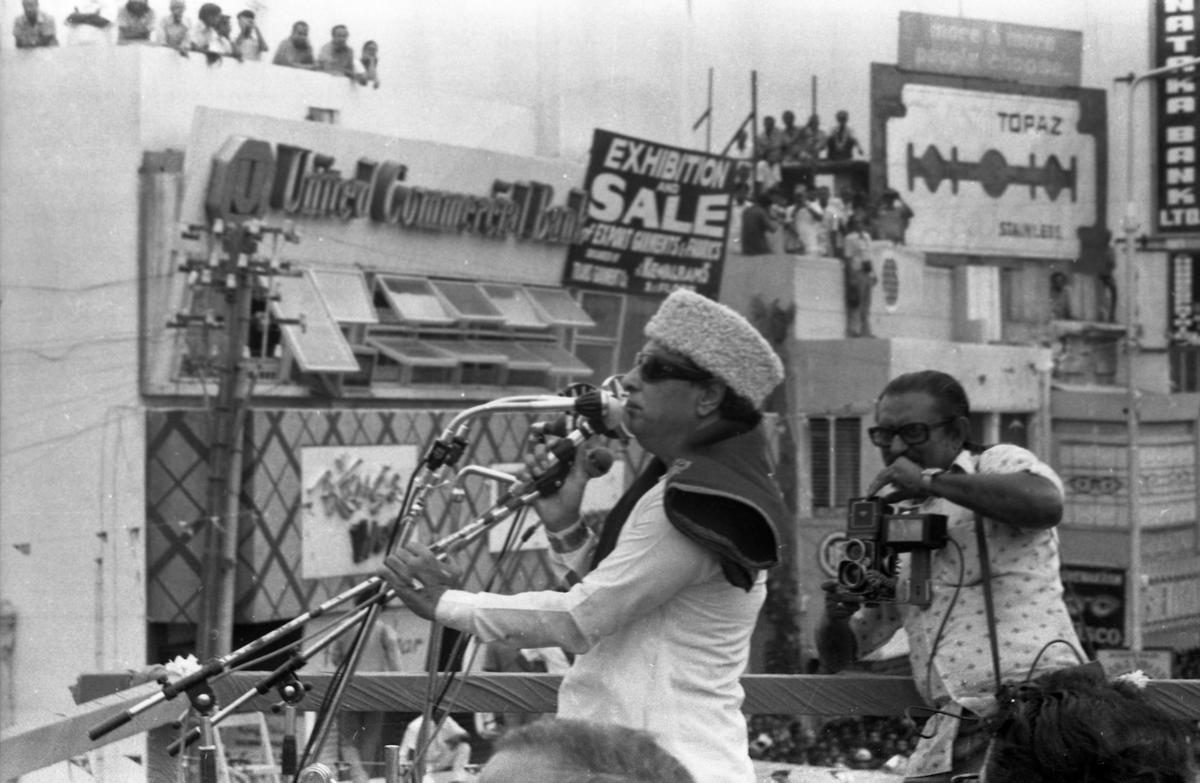The year 1977 was eventful for Tamil Nadu in many respects. It marked the advent of duopoly in the State politics with the DMK and the AIADMK being the principal players, a feature that continues even today. Virtually on his own political strength, the AIADMK founder M.G. Ramachandran (MGR), a leading star in the Tamil cinema, became Chief Minister of the State, a unique record till then. Also, it was then that for the only time, two national parties – the Congress and the Janata – made a serious attempt to capture power in the State.
The year has always been a source of attraction to many, be they from politics or the cinema or any other segment. A Tamil feature film, which was released about 15 years ago, was titled ‘1977,’ though it was a thriller movie. Actor Vijay’s Tamilaga Vettri Kazhagam (TVK), which is planning to enter the electoral fray next year, has been fancying 1977, apart from 1967.

Even though all those who were with MGR now recall that they were confident from the beginning that their leader and the AIADMK would emerge victoriously in the 1977 Assembly poll, there were not many who shared their optimism. Tamil weekly Kumudam had predicted that the Congress, the Janata and the AIADMK would get the first three places and the DMK, the last, according to political analyst R. Kannan in his book, The DMK Years. The actual results were completely different as it was the AIADMK that finished as the winner and the DMK, the runner-up. The Congress and the Janata followed them in this order.
But, one reason for such a forecast was that the year 1977 was a testing period for the DMK. In early March, the interim report of the Sarkaria Commission, which went into alleged corruption committed by the DMK regime in the 1970s, was made public, terming evidence against Karunanidhi and some of his colleagues “cogent, convincing and reliable.”
In the Lok Sabha election held in March 1977, the DMK-Janata-Communist Party of India (Marxist) combine bagged only five out of 39 Lok Sabha seats in Tamil Nadu. The AIADMK-Congress-CPI alliance won in 34 constituencies.
A few weeks after the result, DMK general secretary V.R. Nedunchezhian, who was no. 2 in the Cabinets headed by C.N. Annadurai and M. Karunanidhi, had quit the party along with former Ministers K. Rajaram and S. Madhavan. That the Janata captured power at the Centre in 1977 was of no relief to the DMK, as the national party had, shortly, distanced itself from the Dravidian major, which contested in 230 out of 234 seats in Tamil Nadu. Nedunchezhian had formed the Makkal DMK and extended support to the AIADMK in the Assembly poll.

(from left) M. Karunanidhi, V.R. Nedunchezhian and C.N. Annadurai in Madras. File
| Photo Credit:
The Hindu Archives
As far as the Tamil Nadu unit of the Janata was concerned, it had mostly members of a faction of the Congress (Organisation) under the leadership of P. Ramachandran (Pa Raa) while at the all India level, the national party was made up of the Bharatiya Lok Dal, Bharatiya Jan Sangh and the Socialists.
A follower of former Chief Minister K. Kamaraj, Pa Raa became Union Minister for Energy in the Janata government (1977-79). Another faction of the Congress (O), led by G.K. Moopanar merged itself with the Congress, months after Kamaraj’s death in October 1975.
When the 1977 Assembly election took place, the two national parties – the Congress and the Janata – were vying with each other in appropriating to themselves the vote share – 34.99% – that the Congress (O) secured during the 1971 Assembly poll.
A quick perusal of the poll data of the 1977 election would reveal that the two parties had almost equally divided between themselves what was the “vote bank cultivated” by Kamaraj. Due to a variety of reasons including the political fragmentation of the Janata in 1979-80, the AIADMK had gradually acquired a considerable portion of the “Kamaraj vote bank,” a feature of which could be seen in the 1980 Assembly elections wherein the AIADMK’s vote share, without the support of the Congress or the Janata, rose to 38.74% from 30.36% in 1977, a remarkable rise of about an eight-percentage points in three years.
Unlike in the case of the DMK-Janata relationship which broke all of a sudden, there had been a gradual decline in the ties between the AIADMK and the Congress. The early signs of MGR developing second thoughts about continuing the alliance with the Congress were evident in his interaction with the Press when he returned from New Delhi to Chennai on April 2, 1977 after meeting former Prime Minister Indira Gandhi, who had personally lost in the Rae Bareli Lok Sabha constituency of Uttar Pradesh, and the incumbent, Morarji Desai. While clarifying he had not discussed the alliance issue with either of them for the Assembly poll, MGR pointed out there was “no rift” in the relationship with the Congress. Yet, he said whether the alliance would continue in the Assembly election would be known in due course, according to The Hindu on April 3.

M.G. Ramachandran, then Chief Minister of Tamil Nadu, addressing a huge gathering at Anna Salai in Madras, after the swearing-in ceremony on June 30, 1977
| Photo Credit:
The Hindu Archives
Within a week or so, Nanaji Deshmukh, general secretary of the Janata, hinted at the possibility of his party and the AIADMK coming together. Later in the month, the executive of the Dravidian major had authorised MGR to take a call on the alliance. At the same time, R.M. Veerappan, who was the then headquarters secretary of the AIADMK, told reporters that his party would stake its claim for as many seats as the DMK contested (203 seats) in the 1971 Assembly elections and he would not say “yes” or “no” to a question whether his party’s alliance with the Congress would continue or not.
In mid-May, the State secretary of the CPI, M. Kalyanasundaram, said the suggestion made by allies of the AIADMK was that the Dravidian major contest 150 seats with the balance going to the partners. But, the AIADMK “insisted” on having 185 seats for itself, this newspaper reported on May 15, 1977. Former Union Minister C. Subramaniam criticised the AIADMK for “refusing” to have talk of a minimum programme. The “only commitment” the AIADMK wanted from the alliance parties was that the AIADMK should have about 200 seats so that it should be enabled to form a government on its own, Subramaniam said, addressing a press conference in Chennai on May 22.
That the AIADMK was keen on being able to form a government of its own is confirmed by Panruti S. Ramachandran, who was no. 3 in the MGR Cabinet during 1977-87, and S. Thirunavukkarasar, who was first elected to the Assembly in 1977 and served as Industries and Food Minister in the Cabinet from 1980 to 1987. Both emphasise that MGR was clear there would not be takers in Tamil Nadu for the concept of a coalition government. Mr. Ramachandran adds the move of the AIADMK founder not to maintain the alliance with the Congress had nothing to do with the Janata party but that “pleased Morarji Desai.”
Then Prime Minister Morarji Desai and Chief Minister of Tamil Nadu, M.G. Ramachandran at Madras on September 25, 1978
| Photo Credit:
The Hindu Archives
Prime Minister Desai, Defence Minister Jagjivan Ram, other Cabinet Ministers L.K. Advani, Ravindra Verma, and George Fernandes were drafted for the Janata’s poll work campaigning in different parts of the State. J.B. Kriplani, who functioned as a mentor of the Janata party, the national president of the Janata, Chandra Shekhar and two key office bearers, Deshmukh and Subramanian Swamy were also pressed into the campaign.
As for the Congress, Moopanar, who did not contest in the election, was given the free hand to decide candidates and the issue of alliance, apart from spearheading the campaign. The all-India leadership had remained a mute spectator.
The overall outcome yielded no surprise to anyone, as the AIADMK had emerged victoriously. But, it was the DMK, and not the national parties, that finished next. Since then, there has been no change in the primacy of the two Dravidian parties.






















